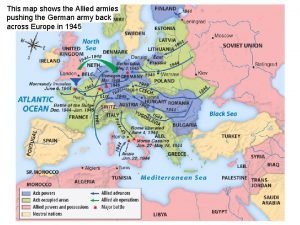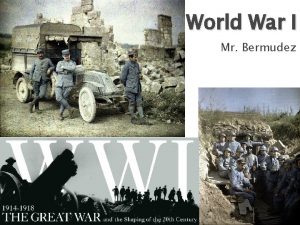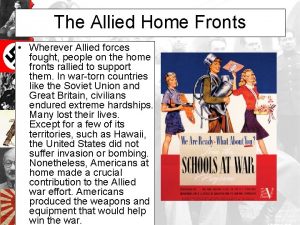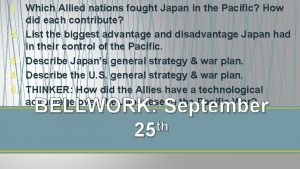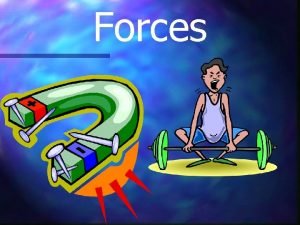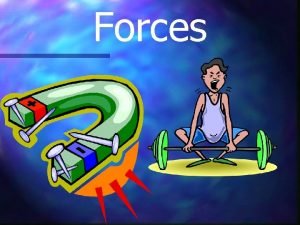The Allied Homefront Wherever Allied forces fought people










- Slides: 10

The Allied Homefront • Wherever Allied forces fought, people on the home fronts rallied to support them even though they too endured hardships (aside from the United States) – Regardless, Americans at home contributed much to the war effort • Automobile factories were commissioned to produce tanks rather than cars – Typewriting companies made armor piercing shells • By 1944, 17 – 18 million women worked in factories to produce munitions, aircraft, etc. • The American government rationed goods such as gasoline, laundry soap, cheese, lard, butter, meats, coal, jams, etc. – Americans had ration books that enabled them to get certain amounts of these goods – couldn’t get more than that • Children saved their pennies to buy war stamps – financed government bonds which financed the war


D-Day • By 1943, Allies were secretly building an invasion force in Great. Invasion Britain – Goal was to launch an attack on German held France across the English Channel (ready by May 1944) – President Roosevelt chose General Dwight D. Eisenhower to command the invading force of – Allies plan invasion of France; use “phantom armies” to make Germans think Allied invasion was elsewhere • Operation Fortitude – set up dummy army that looked like it would attack the city of Calais • D-Day—June 6, 1944 - “Operation Overlord” - invasion of France Allied troops fought their way onto a 60 mile stretch of beach in Normandy – Largest land sea attack in history – Germans had dug in machine guns, rocket launchers, and cannons behind concrete walls – fired on Allied soldiers – Allies took heavy casualties (Americans had over 2, 000 dead on day of invasion) – In July, U. S. Third Army led by General George Patton broke through German Defenses near Saint-Lo –By September, Allied forces Liberated France, Belgium and forced German troops to retreat

Battle of the Bulge and German Surrender • Allied forces moved toward Germany from the west, the Soviet Army was advancing form the east – Hitler faced a war on two fronts; in a desperate gamble, he decided to counterattack in the West in the hopes that a victory would split the American and British forces and break up Allied supply lines German tanks broke through American defenses along a 75 mile front in the Ardennes (forested part of/in northern France) • On December 16, – The push into Allied lines gave the campaign its name – Battle of the Bulge (December) 1944 – German forces bulging/forcing their way into Allied territory (France) – Allies eventually pushed back after being caught off guard; German troops had to retreat since no reinforcements were available • March 1945 – Allies rolled into Germany; April 1945 – Soviets surrounded Berlin and pounded it with artillery fire – Hitler prepared for his end in an underground bunker where he and his companion Eva Braun purportedly committed suicide (bodies were later found) • May 7, 1945 – General Eisenhower accepts surrender from the German military – Roosevelt doesn’t live long enough to witness the surrender; he died on April 12 – Roosevelt’s successor, Harry Truman, became president and accepted the surrender – On May, 1945 the surrender is and the Allies celebrate it as V-E Day – Victory in Europe Day

Franklin Delano Roosevelt Harry S. Truman

The Japanese in Retreat • By 1944, the Allies were moving in on Japan via the Island-Hopping strategy • In October, Allied forces landed on the island of Leyte in the Philippines – General Douglas Mac. Arthur, who had been ordered to withdraw with his troops years earlier, said “People of the Philippine, I have returned” • The Japanese devise a plan that would require risking the Japanese fleet as bait to draw in Allies navy – Plan backfires; Japanese navy suffers devastating defeat (takes it out of the war effort) • 1994 - Battle of Leyte Gulf severely damages Japanese navy Allies reclaimed Philippines – Battle is where Douglas Mac. Arthur fulfils “I shall return” promise and liberates the Philippines • Losses encourage Kamikazes—Pilots who fly suicide missions/cash into enemy units – By June 1945 - Americans capture islands of Okinawa/Iwo Jima – many Japanese casualties • Japan lost over 100, 000 troops in the battle over Okinawa and Iwo Jima; Americans lost 12, 000


The Japanese Surrender • After Okinawa, the next stop for the Allies was Japan. However, advisors warn Truman that invasion of Japan will cost many lives –Learned about the atomic bomb that was developed by the top-secret Manhattan Project headed by General Leslie Groves and Dr. Robert Oppenheimer – Series of facilities spread out in Tennessee, Washington and New Mexico (where they are detonated) – famous for Atomic Spies like Karl Fuchs • First atomic bomb was dropped on July 16, 1945 – Truman warned the Japanese to expect a “rain of ruin from the air” – Japanese didn’t reply • August 6, 1945 – 1 st A-bomb dropped on Hiroshima – terms of surrender were not brought forth by the Japanese • August 9, 1945 – 2 nd A-bomb dropped on Nagasaki – 70 - 75, 000 deaths each – Atomic bombs were known as “Little Boy” and “Fat Man” • Realizing that their country was vulnerable to nuclear strikes by U. S. , Japanese surrender on September 2, 1945 – The Emperor himself took to the airwaves and stated that Japan would cease military aggression with the Allied powers

Enola Gay

 Homefront wsgc
Homefront wsgc Gungoddess holster
Gungoddess holster Battle of midway june 1942
Battle of midway june 1942 Allied forces
Allied forces The map shows that the allied forces
The map shows that the allied forces World war 1 was fought between
World war 1 was fought between Intramolecular forces vs intermolecular
Intramolecular forces vs intermolecular Balanced forces and unbalanced forces venn diagram
Balanced forces and unbalanced forces venn diagram Intra vs intermolecular
Intra vs intermolecular What are destructive forces
What are destructive forces Like parallel force example
Like parallel force example


